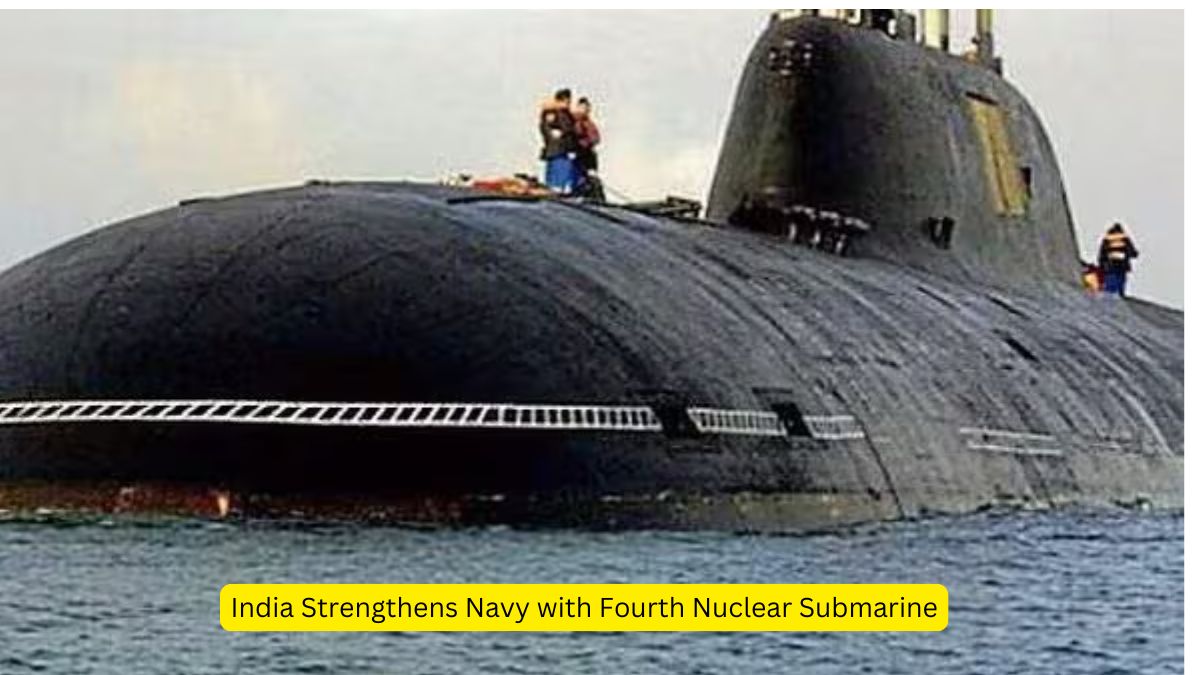India’s fourth nuclear-powered ballistic missile submarine (SSBN), designated S4*, was officially launched into the water at the Ship Building Centre in Visakhapatnam, according to official sources. This advanced submarine represents a significant leap in capability and size compared to its predecessor, INS Arihant (S2), which primarily served as a technology demonstrator under the Advanced Technology Vessel program.
Overview of India’s Fourth SSBN (S4*) Launch
Launch Date
- The fourth nuclear-powered ballistic missile submarine (SSBN), codenamed S4*, was launched on October 16, 2024.
Background Context
- The launch occurred just after Defence Minister Rajnath Singh inaugurated a Very Low Frequency Naval Station in the Damagundam forest area of Vikarabad district, Telangana, which will enhance command, control, and communication with strategic assets of the Indian Navy.
Key Features of S4*
- Indigenous Content : Approximately 75% indigenous components.
- Missile Capability : Equipped with K-4 nuclear ballistic missiles with a range of 3,500 km, which can be launched through vertical launching systems.
Comparison with Predecessors
- The INS Arihant (the first of its class) carries K-15 nuclear missiles with a range of 750 km.
- INS Arighaat and S4* are upgrades and exclusively carry K-4 ballistic missiles.
Operational Capacity
- The S4* SSBN is designed for unlimited range and endurance, with operational constraints primarily related to food supplies, crew fatigue, and maintenance.
Current Patrols
- Both INS Arihant and INS Arighaat are currently on deep-sea patrols, demonstrating India’s commitment to maintaining a continuous strategic presence.
Future Developments
- A Russian Akula-class nuclear-powered attack submarine is expected to join the Indian Navy on lease in 2028, further enhancing its maritime capabilities.
Details on INS Aridhaman (S4*)
Naming Convention
- INS Chakra was designated as S1, followed by INS Arihant as S2, and INS Arighaat as S3.
- The newly launched INS Aridhaman is named S4, making it the last of its class, with the formal name for S4* still pending.
Future Developments
- The next class of Indian SSBNs is expected to have a displacement of 12,000 tons, double that of the Arihant class, and will be capable of carrying nuclear missiles with ranges exceeding 5,000 kilometers.
Strategic Focus
- The Modi government’s strategy emphasizes sea-based nuclear deterrence to counter powerful adversaries, notably China.
- This focus arises from the vulnerability of aircraft carriers to long-range missiles, such as China’s Dong Feng-21 and Dong Feng-26, which pose significant threats in a conflict scenario.
Shift in Naval Priorities
- Due to these threats, India has prioritized the development of nuclear attack and ballistic missile submarines over acquiring a third aircraft carrier, aiming to bolster its underwater combat capabilities.
Conventional Submarine Development
- In addition to the SSBNs, the Indian Navy is enhancing its conventional submarine fleet, with the sixth diesel attack submarine, INS Vagsheer, set to be commissioned in December 2024.
Strategic Implications
New Diesel Attack Submarines
- The Indian government plans to initiate the construction of three advanced diesel attack submarines at Mazagon Dockyards in collaboration with the French Naval Group.
Increased PLA Presence
- The People’s Liberation Army (PLA) Navy has maintained a significant presence in the Indian Ocean, with 10-11 warships operating in the region monthly since last year.
Future Naval Operations
- Long-range carrier-based patrols from the PLA are anticipated between 2025-26, increasing the necessity for India to enhance its maritime defense capabilities.
Role of Strategic Submarines
- In this context, strategic submarines are expected to play a crucial role in:
- Defending Indian maritime interests.
- Maintaining dominance in the Indian Ocean Region (IOR).
| Summary/Static | Details |
| Why in the news? | India’s fourth nuclear-powered ballistic missile submarine (SSBN), designated S4*, was officially launched into the water at the Ship Building Centre in Visakhapatnam |
| Context | Launched after Defence Minister Rajnath Singh’s inauguration of a Very Low Frequency Naval Station. |
| Indigenous Content | Approximately 75% indigenous components |
| Missile Capability | Equipped with K-4 nuclear ballistic missiles (range: 3,500 km) |
| Comparison with Predecessors | – INS Arihant (S2): K-15 missiles (750 km)
– INS Arighaat and S4*: Upgraded with K-4 missiles |
| Operational Capacity | Unlimited range and endurance (constraints: food, crew fatigue, maintenance) |
| Current Patrols | INS Arihant and INS Arighaat on deep-sea patrols |
| Naming Convention | INS Chakra (S1), INS Arihant (S2), INS Arighaat (S3), INS Aridhaman (S4*) |




 Exercise Desert Cyclone II Begins: India...
Exercise Desert Cyclone II Begins: India...
 Army Achieves Major Logistics Milestone ...
Army Achieves Major Logistics Milestone ...
 India and Brazil Sign Tripartite MoU on ...
India and Brazil Sign Tripartite MoU on ...







